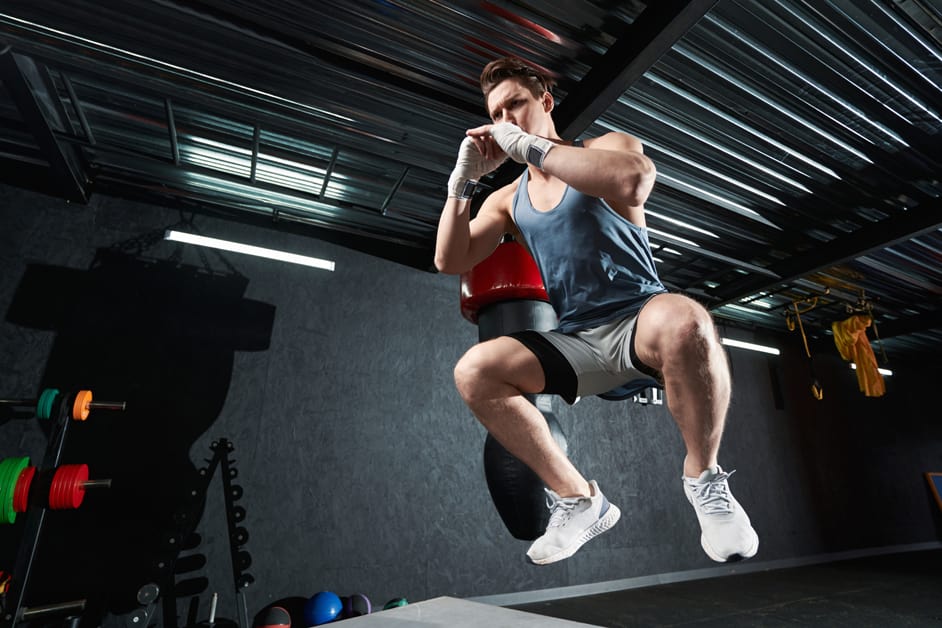Introduction
Plyometrics are special exercises which give athletes explosive power and speed. They help build strength and stability in the knees and improve overall athleticism. This article explains the principles behind plyometrics, the different exercises and how they can help athletic performance.
Benefits of Plyometric Exercises
Plyometric exercises involve bursts of explosive movements, such as jumping, pushing or throwing. They utilize the muscle’s own energy and can help improve athletic performance and muscular strength. These activities also increase agility, balance and coordination. Plus, they can improve bone density for stronger bones over time.
Plyometrics are a safe way to practice movement patterns for better functional performance in sports and daily activities. Lastly, they can raise metabolic rate during the session, leading to improved calorie burning afterwards. All of these benefits make plyometrics worth trying out!
Risks of Plyometric Exercises
Plyometric exercises involve fast, explosive movements. They can help athletes increase speed, strength, and power. But they can also cause harm. Knowing the risks is key before attempting them.
Common injuries include strains and sprains of the lower extremities, like the hamstring and calf muscles. These can happen from overstretching or from too much effort. Ankle sprains can be caused by jumping on unstable surfaces or landing on uneven surfaces. Knee injuries are more likely when form isn’t maintained during drills with squats or lunges with jumps.
Back injuries are possible without enough core stabilization during dynamic movements. Tendinitis can come from overuse of a certain muscle with extreme overloads. Stress fractures can occur from too much training and not enough rest between plyometric workouts.
It’s important to pay attention to form when doing any type of exercise. And be aware of your own body and what it can handle during high-intensity plyometric workouts.
Plyometric Exercises for Knee Strength
Plyometric exercises are awesome for knee and athletic performance enhancement. They involve short, fast movements of muscles and joints. This builds explosive power and athleticism, as well as boosts strength and stability.
Let’s take a look at the perks of plyometric exercises for stronger knees and better athletic performance!
Squat Jumps
Squat jumps are an explosive plyometric exercise to build leg strength and power. Use proper form for best results and to avoid injury.
- Start in the standing position with feet apart, arms down and core muscles engaged.
- Sit back into a squat until thighs are parallel to the ground. Engage glutes and core.
- Drive through heels and jump up off both feet.
- Land softly in the squat position, absorbing impact with bent knees.
- Make sure you land in an athletic stance and maintain good alignment of head, neck, shoulders and back.
- Perform this exercise correctly to build lower body power while improving knee strength.
- Don’t rush or take short cuts – it can lead to injury.
Box Jumps
Box jumps are an awesome plyometric drill for your knees. Athletes and fitness fanatics alike use this explosive jumping move to build power in your knees. It works on your fast-twitch muscle fibers, which are responsible for fast and powerful movements.
Mainly focusing on your quadriceps and hamstrings, box jumps involve jumping onto a platform. How high it is depends on your fitness level and preference – between 6 and 24 inches.
To do it right:
- Stand in front of the box with feet shoulder width apart
- Hinge forward and swing arms back
- Extend hips, knees, and ankles to jump onto the box
- Maintain proper ankle, knee, hip alignment while landing
- Step down or hop off the box horizontally
- Do 10-12 reps
Box jumps will help improve form in motor control, reactive force production, and muscle fiber recruitment. This can help boost performance in activities that involve running or jumping, like basketball or soccer. Do it regularly and it’ll help strengthen and protect your knee joints to avoid injuries in the future.
Single-Leg Jumps
Single-leg jumps are awesome for knee strength, balance and proprioception. Jump with one leg suspended and land on both. This activates more muscles and knee stabilizers than double-leg exercises.
Try these variations, depending on your fitness level: squat-hops, box jumps, lateral hops over a cone or hurdle, split squat jumps and vertical leaps up onto a bench or box. Do 3 sets of 10 reps for each type of jump. Focus on quickness, and land softly to absorb impact safely.
Plyometric Exercises for Improved Athletic Performance
Plyometrics are a kind of exercise that can help fortify your knees, enhance agility, and upgrade athletic performance. Plyometrics demand your muscles to produce the maximum force in a brief time period. This creates explosive power, better coordination, increased speed, and better balance.
In this article, we’ll investigate the different kinds of plyometric exercises and the advantages of having them as part of your workout routine.
Skater Jumps
Skater jumps are a complex plyometric exercise. They improve knee stability and coordination. Muscles in your legs get stronger, helping you to move faster & become more agile. Take time to practice proper form before attempting this move.
- Stand with one foot slightly in front of the other. Weight on the back foot, both knees bent into a low squat.
- Push off from both feet, especially your back foot. Jump side to side like an ice skater. Keep your feet together, landing each time before jumping again. Alternate sides each time until you reach desired reps.
- Push off with enough power so when you land, your knee will be almost straight. This promotes strong knee stability and prevents injury.
Broad Jumps
Broad jumps are a great way to build strength and muscle in your legs. Use it for warm-up or for a high-intensity cardio workout.
- Stand with feet shoulder-width apart.
- Inhale and bend knees.
- Leap forward with all your power. This is an explosive movement.
- As soon as you land, sink into a quarter squat for stability.
- Drive off the ground up and forward onto another jump.
- Repeat 8-10 times. Rest well between sets.
This will improve explosive power in hip flexors and quads. These muscles are important for strong knees and running performance.
Lateral Hops
Lateral plyometric hops are perfect for training hip, knee and ankle muscles for sports that require quick lateral movements, such as basketball and soccer.
Start by standing with feet slightly wider than hip-width apart, arms at your sides. Jump from one side to the other. Land with bent knees, sink into a quarter-squat and then push off the ground to jump back to your starting position. Keep your core engaged throughout the exercise. This will help keep your lower body stable for a better jump.
Aim for 3 sets of 10 reps on each side initially. Increase reps or sets as you become more confident.
When practicing, avoid hopping on hard surfaces – use a rubber mat or grassy area instead.
Safety Considerations
Safety is a must before any exercise. Especially for plyometric exercises! These exercises help you get more explosive power. But, if you don’t take precautions, they can be dangerous.
Here, we’ll discuss the safety measures for plyometric exercises. So you can enhance your athletic performance and be safe. Plus, strengthen your knees!
Proper Warm-up
Safety is key when operating heavy equipment and machinery. To stay safe and reduce the risk of injury, it is important to warm-up machines properly.
- Start with a visual inspection. Check for any potential hazards or malfunctions, like leaks or loose components.
- Next, slowly raise engine speed and/or pressure until it reaches the desired level. Adjust settings as needed. This helps reduce wear on components.
- Allow a few minutes for oil to settle before further use.
Following these steps keeps people safe and optimizes machine performance.
Proper Form
When doing plyometrics, it’s key to keep proper form. Movements may be complex, but if you use good body mechanics, you’ll benefit more and lessen the risk of injury.
Focus on balance, not speed or power. Even if you’re familiar with the movements, take time to practice each rep slowly and get used to the range of motion and muscle engagement. Pay attention to your feet and knee alignment during each repetition. Bad form impacts performance and raises the risk of injury.
Be aware of which muscles you’re using and how they work while exercising. Take note of proprioception—your sense of where your body parts are—and understand how muscle fatigue affects execution. This helps with postural alignment and may reduce knee pain from exercise. Plyometric exercises included!
Proper Shoes
Proper shoes are essential for workplace safety. There are various types of safety shoes available, including steel-toe boots, non-slip and slip-resistant shoes, puncture-resistant soles and leather uppers for flammability resistance. Choose a shoe that fits your foot and its intended job function.
Before purchasing, ensure the shoe meets your needs. Different steel toe constructions offer various levels of protection from hazards like falling objects or electrical shock. If you need chemical or water-resistant footwear, find out which sole best suits your needs.
Once you have the shoe for protection, keep it clean and well maintained. Check for worn soles that affect traction and damaged uppers that no longer provide insulation or flammability resistance. Read manufacturer guidelines and warnings before using the product.
Conclusion
Plyometric exercises are awesome! They help build strength, enhance knee stability and give a great cardio workout. Plus, they’re easy to learn and fun to do.
For best results, it’s important to work with experts like certified trainers or physical therapists who can help with technique, intensity, and exercise selection. Before starting, check with your doctor. And don’t forget to warm-up properly. This helps reduce stress on your joints and lowers the risk of injury.
Frequently Asked Questions
Q1: What are plyometric exercises?
A1: Plyometric exercises are exercises that use explosive movements to build strength and power, helping with athletic performance. They involve quickly stretching and contracting muscles to increase muscle power, helping you jump higher, run faster, and move with more agility.
Q2: What are the benefits of plyometric exercises?
A2: Plyometric exercises are beneficial for athletes because they can help build stronger muscles and increase agility and speed. They can also help increase coordination and balance and can help strengthen your knees and reduce the risk of injury.
Q3: How often should I do plyometric exercises?
A3: Plyometric exercises should be done two to three times per week for optimal results. It is important to warm up and stretch before and after each session to avoid injuries.





